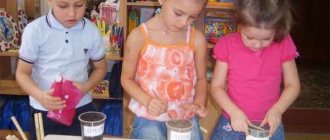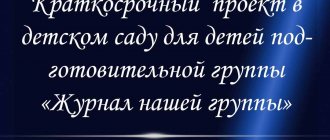Project “Our health is in our hands” in the middle group “Carousel”
«About vitamins and health"
Author of the tale:
Iris Review
In a certain kingdom, in a certain state, there lived cheerful and good people. And the Clever King ruled over them. The king vigilantly ensured that all people were healthy: they breathed fresh air, did morning exercises, followed a daily routine, and ate healthy food.
But then one day everything went wrong in this kingdom. And this happened after the visit of a fierce snowstorm - all the fruits and vegetables in the kingdom froze. Oranges, lemons, beets, cabbage, onions and others stopped getting onto people’s tables, and along with them vitamins.
Do you, reader, know what vitamins are? These are useful substances that are needed for a person to be healthy. They are found in large quantities in vegetables and fruits, cereals and other foods. Vitamins, just like people, have their own names. For example, these are: Vitamin A1, Vitamin B2, Vitamin C, Vitamin E, Vitamin D5. Beautiful names, right?
There were no vegetables and fruits in the kingdom—vitamins stopped getting into people’s bodies—and children and adults began to get sick.
And then the Smart Tsar came up with this. With the help of scientists, he created new vitamins - vitamins in balls and tablets. They were good, but not as beneficial as real, natural vitamins, but they protected people from disease.
And then people asked the Golden Sun to shine brighter, the Generous Rain to spare no drops, and they planted new orange and lemon trees; sowed cabbage, beets, carrots, and onions. We also grew other vitamin-rich fruits and vegetables.
And everything got better. People became healthy and cheerful again.
Unusual vegetable garden"
Once upon a time there lived a boy, Petya. He really didn't like brushing his teeth. Every morning his mother reminded him: “Go brush your teeth!” - I do not want and I will not! - Petya whined.
Mom got tired of his whims and decided: “He doesn’t want to brush his teeth and doesn’t need to. Let's see what comes of it." In the evening Petya had dinner and went to bed. Of course, he didn’t brush his teeth, because his mother didn’t remind him. Morning has come. The birds chirped merrily. The boys ran to the river. Petya stretched sweetly in his crib. Mom was preparing breakfast in the kitchen. “Petya, get up, go brush your teeth,” my mother couldn’t stand it. He opened his mouth to say, “I don’t want to, I won’t.” But to his surprise he discovered that he could not utter a single word. In the evening Petya was eating cucumbers and one grain got stuck between his teeth and cucumbers grew in that place. I ate a tomato - and the tomatoes grew, and the onions grew, and the radishes. And all this sticks out of the mouth in different directions. Petya was scared. I wanted to call my mother, but I couldn’t. Instead of words, some kind of mooing is heard. Mom heard this. She ran up to Petya. Mom clasped her hands and was very surprised: “Petya, now you don’t have a mouth, but a whole garden!” Then she got used to such a garden and even liked it - she doesn’t have to go to the market to buy vegetables, everything is nearby. She needs to make a salad, go to Petya’s, pick cucumbers, tomatoes, onions, and radishes. Very comfortably. Only Petya is not happy. He can’t run with the boys - they’ll laugh at him. He can’t eat, he can’t speak—various twigs, bushes, tomatoes, and cucumbers are sticking out of his mouth. The mouth doesn't close at all - it's hard. Several days passed. Petya was completely exhausted. Yes, another problem has come - holes have appeared in the teeth, and microbes have appeared in them, which destroy the teeth. All of Petya’s teeth started to hurt. The poor thing began to cry and mumbled for his mother to call the doctor. The doctor came and was very surprised: “You don’t have a mouth, but a whole garden.” The doctor pulled out all the bushes from his mouth, found holes in the teeth, scraped out pieces of food from them, and all the microbes that were hidden in the corners of the teeth. Then the doctor sealed all the holes with a special putty - a filling. If the filling is not placed, the microbes will return to their places and the teeth will hurt again. Petya sat calmly, listened to the doctor and strictly followed all his instructions. Finally, it's over. Petin's mouth literally closed from fatigue. Petya was very happy. Now he brushes his teeth every day after meals, both in the morning and in the evening, and advises all the guys to do the same.
Short-term project in a middle group on the topic: Healthy lifestyle in kindergarten
Short-term project on the topic: Healthy lifestyle in kindergarten for children 4-5 years old
Author: teacher of MDOU kindergarten No. 9 “Swallow”; teacher: Lagutina S.S.
Relevance
.
Currently, it is quite quickly characterized by changes in the natural and social environment, and also leads to physical, mental, cultural, moral and other changes in every person. Therefore, the most pressing problem today is preserving and strengthening the health of children. V.A.
Sukhomlinsky wrote : “I am not afraid to repeat again and again: caring for the health of a child is the most important work of a teacher...”
Health is considered as complete physical, mental and social well-being, as a harmonious state of the body, which allows a person to be active in his life and achieve success in various activities. To achieve harmony with nature, you need to learn to take care of your health from childhood. It is very important today to develop in preschool children motives, concepts, and beliefs in the need to preserve their health and strengthen it by introducing them to a healthy and safe lifestyle. The significance of the application of this work is determined by the solution of corrective problems of improving the health of preschool children, fostering a culture of a safe and healthy lifestyle - creating a solid foundation for raising a healthy child Problem:
Currently, a large number of children have health problems.
The proposed Health Week project makes it possible to strengthen the somatic condition of children in a correctional group. Project goal:
To form in children initial ideas about health and a healthy lifestyle.
To consolidate children's knowledge about the parts of their body and their functions, about how to take care of their health and why. Objectives:
to increase children’s interest in a healthy lifestyle through various forms and methods of physical education and health work; continue to introduce children to the rules of hygiene; promote the health of children through a system of health-improving activities; increase the pedagogical competence of parents on the issue of preserving and strengthening the health of the child; instilling interest in various sports through cognitive activity; motivation to lead a healthy lifestyle within the project and outside it; education of moral behavior; introduction of health-saving technologies into the educational process, organization of a health-saving environment for the beneficial physical development of children.
Project type:
short.
Age of participants:
preschoolers 4-5 years of middle group
Duration of the project:
2 weeks
Main forms of project implementation:
conversations, children's creativity, games, work with parents.
Forms and methods of educational activities I. WORKING WITH PARENTS
Memos for parents • “Personal hygiene” • “Food hygiene” Consultation for parents “How to get your child interested in daily dental hygiene?” 6. Team work (children, parents, teachers): “Healthy products” II. WORK WITH CHILDREN
1. Morning exercises “Bunnies improve health” 2. Routine moment “Invigorating gymnastics “We woke up and smiled at each other” 3. Routine moment “KGN “Wash your hands clean and clean” 4. Articulation gymnastics 5. Outdoor game • “Best pedestrian” • “Vegetables and fruits” • “Assemble a traffic light” 6. Didactic games: • “Helpful or not useful” (story pictures according to the seasons) • “Lotto “Who lives where?” (animals and their young) • “Is it in the garden, in the vegetable garden?” (vegetables and fruits) • “Pick up pictures” (clothing) • “Healthy treat” (dishes) • “Insert correctly” (transport) 7. Learning proverbs and sayings. 8. Modeling “Fruits for the cubs” 9. Coloring templates “Vegetables” 10. Conversations: • “Personal hygiene” • “We grow up healthy” • “We wash our hands before eating” 11. Situational conversations: • “Is it possible to bite your nails” • “Healthy food” • “Vitamins strengthen the body” • “Why you need to sleep” 12. Solution to a problem situation “Let’s remind Masha how to dress”
13. Solving problematic issues “What will happen if...”. 14. Reading fiction: • K. Kuznetsov “Zamarashka”, • S. Marshak “Why a person has two hands and one tongue”, • G. Zaitsev “Lessons of Moidodyr”,
15. Role-playing games: • “Polyclinic” • “Hospital” • “Ambulance” Expected result of the project:
1. Increasing the level of awareness of the importance of observing CGN in adults and children 60% 2. Increasing the number of children having personal hygiene products 90%
3. High level of KGN-50% Efficiency criteria.
The goal has been achieved: the number of active project participants is 60%
Project results:
1. Parents drew attention to the problem of instilling hygiene skills in their children. 2. Parents have become more attentive to the appearance of their children (they bring their children neat in the morning).
3. They began to pay more attention to the child’s hygiene (nails were trimmed, ears were clean, children had handkerchiefs).
4. Children are happy to perform hygienic actions (wash their hands, rinse their mouths after eating, use a towel, handkerchief correctly, etc.) 5. Girls are happy to go braiding. 6. In general, the appearance of children has become more neat. List of sources of information and illustrations
1. Federal state educational standard for preschool education (order of the Ministry of Education and Science of Russia dated October 17, 2013 No. 1155) 2. Federal Law of the Russian Federation dated December 29, 2012 No. 273-FZ “On Education in the Russian Federation.” 3. Magazine “Preschool Education” No. 2 – 1992 4. Pavlova M.A., M.V. Lysogorskaya “Health saving system of a preschool educational institution”, - 2009 5. Krylova N.I. “Health saving space in preschool educational institutions. Design, trainings, classes,” – 2009. 6. Sherbak, A. “Towards harmony through movement!”, Magazine “Preschool Education”, 1998 - No. 6.8 7. All photographs used are from the author’s personal archive.



